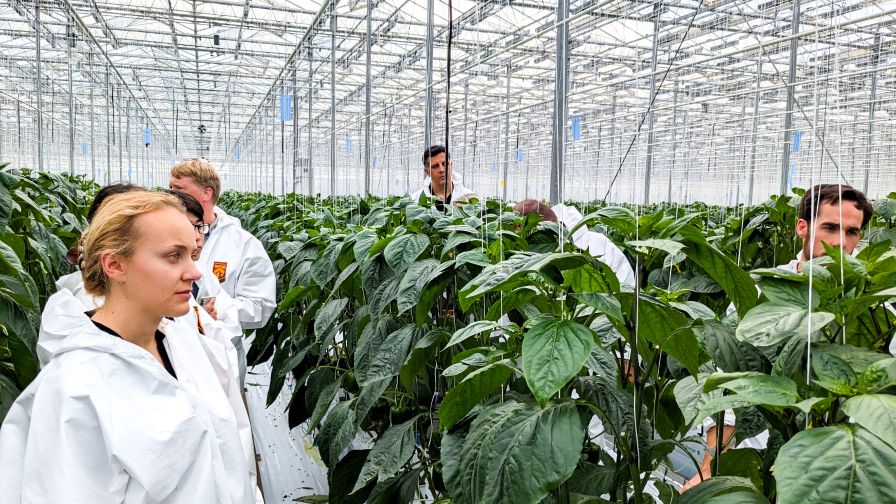When Tech Companies and Universities Team Up, Growers Succeed

In October, GLASE held its Summit in Leamington, Ontario, where attendees went on a tour of Horteca, a cucumber greenhouse operation. Photo: Gretchen Schimelpfenig
Tech companies and universities are partnering to jointly generate ideas, test them in the field, and commercialize them. While one group is for-profit and the other isn’t, the two pair well together. When tech companies partner with research institutions to bring new ideas from research into production, growers benefit, too. White papers and trial results from these partnerships are unbiased and repeatable, allowing growers to evaluate and make solid decisions about new methods or equipment.
GLASE (Greenhouse Lighting and Systems Engineering) is based out of Cornell University and includes researchers from Cornell, Rensselaer Polytechnic Institute, and Rutgers University. Founded on a public-private membership model, GLASE has an industry advisory board. Although initially funded by NYSERDA (New York State Energy Research and Development Authority), they’re not limited to government-sponsored projects.
“Via our Industry Advisory Board, we also perform our research with the input of the tech companies and the growers, the utilities, and other stakeholders,” says Gretchen Schimelpfenig, Executive Director of GLASE. “I would say that GLASE stands firmly in the academic arena, but we have endeavored since our creation to get buy-in from our private industry members.”
GLASE acts as a facilitator between academia and industry.
“We like to consider ourselves a specialized Extension, like USDA Extension offices, which are meant to be that bridge from academia into the industry of growers and farmers,” says Schimelpfenig. But I would say that GLASE focuses on the high-tech emerging technology of greenhouses. We’re showcasing the newest and most recently proven information about this technology for greenhouse and controlled-environment agriculture applications.”
Horteca is a recent joint venture between JEM Farms and ecoation. Last year, it announced a partnership with the University of Windsor to establish and operate a 2-acre greenhouse for research and collaboration opportunities with industry and community partners. The university will be able to provide hands-on training for students, and the space will provide industry opportunities to field test new technologies.
Vineland Research and Innovation Centre is taking the idea to a new level — the more the merrier. According to its 2023-2024 Innovation Report, Vineland facilitates research collaboration among 238 partners, including more than 200 industrial companies, 15 academic institutions, and 17 governmental organizations.
Everyone knows a university always needs funding. Research is costly to conduct. With many industry-academia partnerships, funding comes not from the tech company but from grants, whether by governments or other institutions. Clear and transparent funding reduces any conflict of interest questions.
Greenhouse operators want unbiased, trustworthy data and evaluation of ideas and tech. Transparency is important. Partnering with universities provides a trust factor.
Benefits to Industry and University Alike
One might assume that the benefits are one-sided, but that’s not the case.
“Koidra is at the frontier of AI. So, we seek to collaborate with the top professors and researchers in the controlled-environment growing domains. Together, we can push the state of the art at a higher speed.
In general, research collaboration and ideas exchange are very valuable for companies who work on innovations,” says Dr. Kenneth Tran, founder and CTO of Koidra. “For our partnerships with universities on funded projects, the initial trials always start at the university. We want to do research in locations, such as the Ohio Controlled Environment Agriculture Center, that best approximate the high-tech greenhouses of our customers.”
Partnering with industry opens doors for researchers. Some funding programs demand that a research institution include industry partners.
“Right now, we’re applying to a big funding opportunity for the USDA Specialty Crop Research Initiative, which is a great example of academic collaboration with private industry because it’s a coordinated agricultural project, which requires that it be transdisciplinary. It can’t just be a bunch of academics doing research by themselves. It has to include industry and co-produce the knowledge and co-disseminate the knowledge with the industry: the growers, the manufacturers,” says Schimelpfenig. “And so, that’s an exciting example of collaboration that we’re doing with GLASE members, as well as national labs, researchers from other academic institutions, and technology partners across many systems such as lighting, HVAC, and greenhouse construction.”
Industry partners benefit from direct access to research teams with expertise and experience. Organizations like GLASE and Vineland also foster connections between industry members. Growers can become members, too, and benefit from the latest technology, research, and experts. Partnerships between tech and academia can demonstrate real-world testing of products, proving the product is ready for adoption in commercial greenhouses, not just in a lab.
Working with the leading experts in the field (greenhouse) has obvious benefits, but as Tran explained, it goes deeper than that. Koidra finds marketing value in these partnerships by demonstrating thought leadership, which Tran says is a derivative of working with brilliant minds. Association with a respected university brings credibility, which has real-world value.
The Need for More Partnerships
With growers turning to tech for help with problems including labor shortages, rising energy costs, disease pressure, and efficiency, the need for more research, trials, and tested solutions to reach growers is increasing rapidly. Industry-academia partnerships for R&D are vital to solving these problems and developing the close working relationships necessary to spur innovation.
“Speaking from GLASE’s perspective, a lot of research has focused on lighting, and we need more investment in other pieces of the greenhouse systems like controls, HVAC systems, and greenhouse coverings,” says Schimelpfenig. “I think there’s actually a dearth of research in the greenhouse coverings space compared to lighting. More investment from the companies who make high-performance glass and acrylic materials, energy-efficient HVAC systems, and autonomous controls systems and proving them out in U.S. climate zones is something that we really need.” She also views these systems as crucial research areas to reduce energy consumption in CEA.








